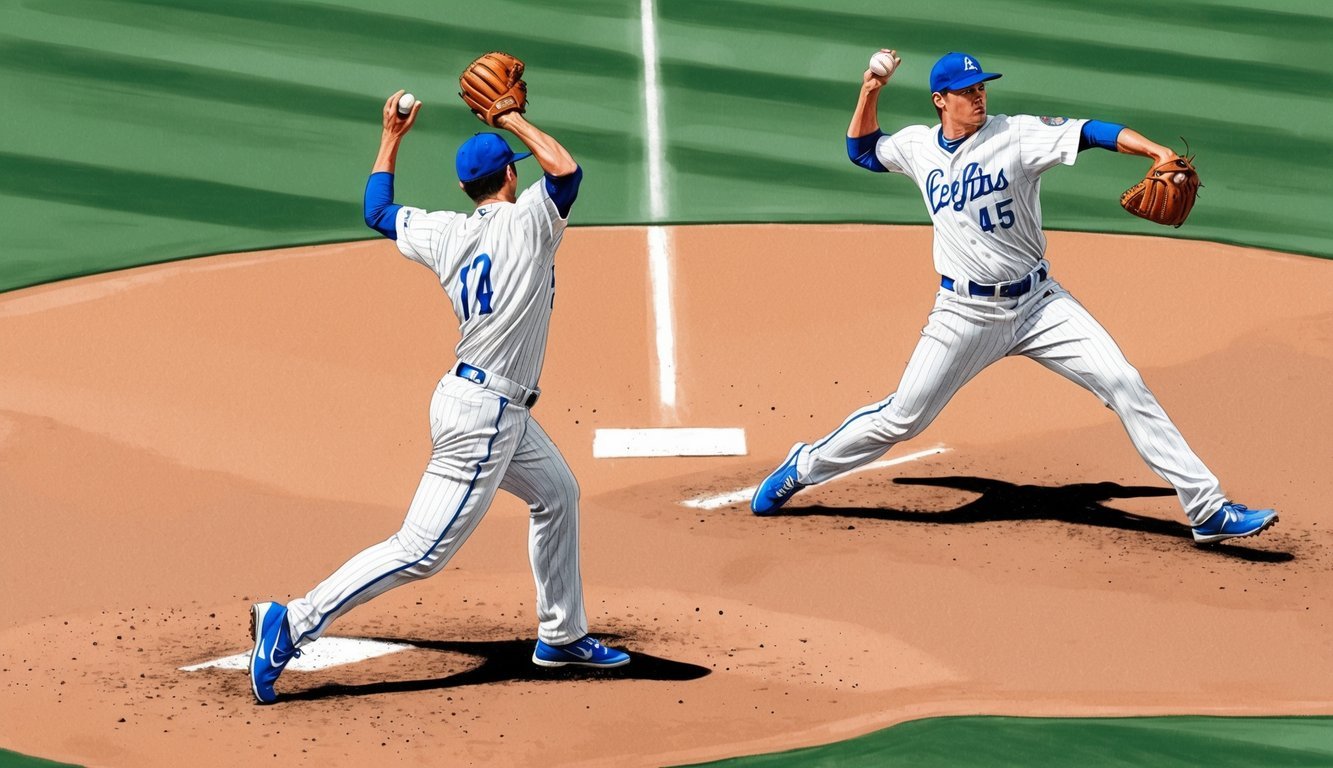Baseball has a long history of unique pitches, but few are as fascinating as the eephus.
This slow, high-arcing pitch baffles batters with its unexpected trajectory and low velocity.
Rip Sewell invented the eephus pitch in the 1940s.
Pitchers can use it to disrupt a batter’s timing by using it sparingly.
The origins of the eephus are as intriguing as the pitch itself.
Sewell developed it after injuring his foot in a hunting accident, adapting his pitching style to compensate.
The name “eephus” reportedly comes from a Hebrew word meaning “nothing,” which aptly describes how this pitch seems to float towards home plate.
Over the years, several notable pitchers have employed the eephus to great effect.
From Steve Hamilton’s “Folly Floater” to Vicente Padilla’s “soap bubble,” this unconventional pitch continues to surprise and entertain baseball fans.
While not a common sight on the diamond, the eephus remains a testament to the creativity and strategy that make baseball such a beloved sport.
Origins of the Eephus Pitch
The eephus pitch emerged from an unexpected source and gained its unique name through a quirky exchange.
This slow, high-arcing pitch has roots in both injury and invention.
Rip Sewell and the Invention
Rip Sewell, a pitcher for the Pittsburgh Pirates, created the eephus pitch in 1942.
A hunting accident left Sewell with an injured foot, forcing him to adapt his pitching style.
He developed a slow, looping pitch that traveled high in the air before dropping sharply.
This unusual delivery confused batters and gave Sewell a new weapon on the mound.
Sewell’s teammates were initially skeptical of the pitch.
However, its effectiveness in games quickly won them over.
The eephus became Sewell’s signature, helping him achieve success in the major leagues despite his injury.
The Name ‘Eephus’
The term “eephus” originated from a conversation between Sewell and his Pirates teammate, Maurice Van Robays.
When asked to describe the peculiar pitch, Van Robays reportedly said, “Eephus ain’t nothing, and that’s a nothing pitch.”
The word “eephus” is believed to come from the Hebrew word “efes,” meaning zero or nothing.
This name perfectly captured the nature of the pitch – a slow, seemingly ineffective toss that often caught batters off guard.
The moniker stuck, and the eephus pitch became a part of baseball lore.
Notable Eephus Pitches in MLB History
The eephus pitch has produced some memorable moments in baseball history.
From All-Star Games to regular season matchups, this slow, looping pitch has baffled hitters and delighted fans.
Ted Williams’ Home Run in the 1946 All-Star Game
In the 1946 All-Star Game, Ted Williams faced an eephus pitch from Rip Sewell.
The Pittsburgh Pirates hurler was known for his high-arcing “blooper pitch.” Williams, one of the greatest hitters ever, initially looked fooled by the slow lob.
As the ball floated towards the plate, Williams regained his composure.
He stepped forward and swung, launching the eephus over the right field wall for a home run.
This moment showcased Williams’ exceptional hitting ability and quick adjustments at the plate.
The crowd at Fenway Park erupted as their Red Sox hero circled the bases.
This home run remains one of the most famous eephus-related plays in MLB history.
Dave LaRoche’s ‘LaLob’
Dave LaRoche, a relief pitcher in the 1970s and 80s, put his own spin on the eephus.
He called his version the “LaLob” and used it to great effect during his career.
LaRoche’s pitch would arc high above the batter, sometimes reaching 20 feet in height.
The LaLob became LaRoche’s signature pitch.
He used it sparingly but effectively, often catching batters off guard.
In one memorable instance, LaRoche threw three consecutive LaLobs to Gorman Thomas of the Milwaukee Brewers.
Thomas swung and missed at the first two before watching the third float in for a called strike.
The LaLob helped LaRoche carve out a successful 14-year MLB career as a reliever.
Bill ‘Spaceman’ Lee’s ‘Spaceball’
Bill Lee, nicknamed “Spaceman” for his eccentric personality, had his own variation of the eephus pitch.
He called it the “Spaceball” or “Leephus,” a play on his last name.
Lee’s pitch was a slow, arcing curveball that often dipped below 50 mph.
Lee used the Spaceball throughout his career, most notably with the Boston Red Sox and Montreal Expos.
In the 1975 World Series, Lee threw his Spaceball to Tony Perez of the Cincinnati Reds.
Perez, initially fooled, managed to hit a home run off the pitch.
Despite this setback, Lee continued to use the Spaceball as part of his pitching arsenal.
His unique approach and personality made him a fan favorite throughout his career.
Pitch Mechanics and Execution

The eephus pitch combines a distinctive high arc with extremely slow velocity to disrupt a batter’s timing.
This unique delivery requires precise mechanics and strategic execution to be effective.
High Arc and Slow Velocity
The eephus pitch starts with an exaggerated overhand throwing motion.
The pitcher releases the ball with a high upward trajectory, sending it soaring up to 20-30 feet in the air.
This extreme arc is key to the pitch’s deception.
As the ball descends, it enters the strike zone at a much steeper angle than typical pitches.
The velocity of an eephus is shockingly slow, often ranging from 35-55 mph.
This is less than half the speed of an average Major League fastball.
The dramatic speed difference throws off a batter’s timing.
Hitters must resist the urge to swing early as the lofty pitch floats towards the plate.
The eephus challenges a batter’s patience and pitch recognition skills.
The Deceptive Strategy
Pitchers use the eephus as a surprise weapon to keep hitters off-balance.
It’s most effective when mixed in sparingly with faster pitches.
The extreme change of pace disrupts a batter’s rhythm and can lead to weak contact or swings and misses.
Some pitchers add backspin to make the eephus harder to track.
This can cause the ball to appear to rise as it approaches the plate.
The unusual movement further complicates the batter’s ability to time their swing correctly.
Strategic use of the strike zone is crucial.
Eephus pitches often start high out of the zone before dropping in for a strike.
This makes them difficult to lay off but also challenging to hit solidly.
Psychology and Effectiveness

The eephus pitch plays mind games with batters, disrupting their rhythm and expectations.
This slow, high-arcing pitch challenges hitters mentally as much as physically.
Disrupting Batter Timing
The eephus pitch’s effectiveness lies in its ability to throw off a batter’s timing.
Most hitters expect fastballs or breaking balls within a certain velocity range.
When faced with a drastically slower pitch, their internal clock gets scrambled.
This “nothing pitch” forces batters to adjust their swing speed mid-motion.
The sudden change can lead to embarrassing whiffs or weak contact.
Even if a batter recognizes the eephus, the temptation to crush such a slow pitch often results in overswinging.
MLB pitchers who master this “folly floater” gain a psychological edge.
Batters become hesitant, unsure what to expect next.
The Art of Surprise
The eephus pitch thrives on the element of surprise.
Pitchers typically use it sparingly, making its appearance unpredictable.
This “trick pitch” keeps hitters off-balance and guessing.
When thrown at the right moment, the eephus can be devastating.
A batter geared up for a fastball suddenly sees a “spaceball” floating towards them.
The mental adjustment required often leads to indecision or poor swing choices.
Some pitchers add to the surprise by disguising their eephus delivery.
They may use the same arm motion as their fastball, making it harder for batters to spot the “blooper pitch” early.
This strategic deception not only confuses hitters but also heightens the thrill of the game.
In addition to such clever pitching techniques, players often utilize gear that enhances their performance, with baseball sliding mitt benefits being a key advantage during close plays.
These specialized mitts provide better grip and protection, allowing players to make daring moves while minimizing the risk of injury.
Contemporary Usage and Legacy

The eephus pitch continues to surprise and entertain in modern baseball.
Some pitchers still deploy this unconventional offering, while its legacy extends beyond the diamond into popular culture.
Modern Players Who Have Utilized the Eephus
Yu Darvish has become known for his slow, arcing pitch that leaves batters guessing.
The right-hander’s version of the eephus, which he calls a “slow curve,” often clocks in below 70 mph.
Zack Greinke, another crafty veteran, has occasionally mixed in the pitch to keep hitters off-balance.
Vicente Padilla’s “soap bubble” pitch and Casey Fossum’s “Fossum Flip” were memorable incarnations of the eephus in the early 2000s.
More recently, Clayton Kershaw has experimented with a super-slow curveball that some consider an eephus variant.
Liván Hernández and Fernando Abad have also tossed this quirky pitch, demonstrating its enduring appeal across different eras and pitching styles.
Eephus Pitch in Popular Culture
The eephus has captured imaginations beyond the baseball diamond.
Its name alone intrigues fans and non-fans alike, often sparking curiosity about its origins and effectiveness.
Baseball video games have incorporated the eephus, allowing players to experience the thrill of throwing or hitting this unusual pitch.
Gamers love using it to surprise their virtual opponents.
The pitch has also made appearances in baseball-themed movies and TV shows.
It’s typically used to highlight a character’s craftiness or unconventional approach to the game.
Baseball cards featuring pitchers known for their eephus offerings have become collector’s items.
They celebrate this unique aspect of the sport’s history and strategy.
